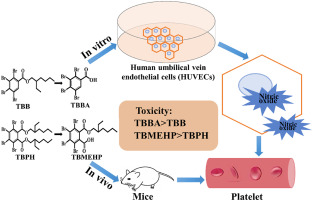当前位置:
X-MOL 学术
›
Chemosphere
›
论文详情
Our official English website, www.x-mol.net, welcomes your
feedback! (Note: you will need to create a separate account there.)
Effects of novel brominated flame retardants and metabolites on cytotoxicity in human umbilical vein endothelial cells.
Chemosphere ( IF 8.1 ) Pub Date : 2020-04-03 , DOI: 10.1016/j.chemosphere.2020.126653 Yi Chen 1 , Mengfan Guo 1 , Rongyan Liu 1 , Lena Q Ma 2 , Xinyi Cui 1
Chemosphere ( IF 8.1 ) Pub Date : 2020-04-03 , DOI: 10.1016/j.chemosphere.2020.126653 Yi Chen 1 , Mengfan Guo 1 , Rongyan Liu 1 , Lena Q Ma 2 , Xinyi Cui 1
Affiliation

|
Novel brominated flame retardants (NBFRs) have been widely used and frequently detected in various environmental matrices. In this study, 2-ethylhexyl-2,3,4,5-tetrabromobenzoate (TBB), bis-(2-ethylhexyl) tetrabromophthalate (TBPH) and their metabolites (namely 2,3,4,5-tetra-bromo benzoic acid (TBBA) and mono(2-ethylhexyl) tetrabromophthalate (TBMEHP)) were exposed to human umbilical vein endothelial cells (HUVECs). Metabolites can induce stronger cytotoxicity than parent compounds with EC50 at 47.3 (TBBA), 8.6 μg/ml (TBMEHP) vs > 200 μg/mL for parent compounds. Gene expression of platelet endothelial cell adhesion molecule-1, the gene associated with blood platelet kinetics, was significantly induced under TBBA and TBMEHP exposure. The in vivo test was consistent with gene expression result that the number of platelets in mouse blood was significantly increased after gavaged with 0.8 μg/mL TBBA and TBMEHP. In addition, TBB or TBPH were exposed to mice via gavage, and higher concentrations of TBBA (4 h, 60.8 ± 12.9 ng/mL, 8 h, 69.4 ± 2.24 ng/mL) in mouse blood were found than those of TBMEHP (4 h, 17.2 ± 4.01 ng/mL, 8 h, 12.8 ± 3.20 ng/mL), indicating that TBB was more readily in vivo metabolized than TBPH. The in vivo metabolism of TBB and TBPH and the stronger toxicity of their metabolites underscore the potential risk through NBFR exposure and the importance of understanding NBFR metabolism process.
中文翻译:

新型溴化阻燃剂和代谢产物对人脐静脉内皮细胞的细胞毒性的影响。
新型溴化阻燃剂(NBFR)已被广泛使用,并经常在各种环境基质中检测到。在这项研究中,2-乙基己基-2,3,4,5-四溴苯甲酸酯(TBB),双-(2-乙基己基)四溴邻苯二甲酸酯(TBPH)及其代谢物(即2,3,4,5-四溴苯甲酸) (TBBA)和单(2-乙基己基)四溴邻苯二甲酸酯(TBMEHP))暴露于人脐静脉内皮细胞(HUVEC)。代谢物比母体化合物具有更强的细胞毒性,EC50为47.3(TBBA),8.6μg/ ml(TBMEHP),而母体化合物> 200μg/ mL。在TBBA和TBMEHP暴露下,血小板内皮细胞粘附分子-1(与血小板动力学相关的基因)的基因表达被显着诱导。体内试验与基因表达结果一致,即用0.8μg/ mL TBBA和TBMEHP灌胃后,小鼠血液中的血小板数量显着增加。此外,TBB或TBPH通过管饲法暴露于小鼠,与TBMEHP相比,小鼠血液中的TBBA浓度更高(4 h,60.8±12.9 ng / mL,8 h,69.4±2.24 ng / mL)(4 h,17.2±4.01 ng / mL,8 h,12.8±3.20 ng / mL),表明TBB比TBPH更容易在体内代谢。TBB和TBPH的体内代谢及其代谢物的较强毒性强调了通过NBFR暴露的潜在风险以及了解NBFR代谢过程的重要性。与TBMEHP(4 h,17.2±4.01 ng / mL,8 h,12.8±3.20 ng / mL)相比,在小鼠血液中发现9 ng / mL,8 h,69.4±2.24 ng / mL),表明TBB在体内比TBPH更容易代谢。TBB和TBPH的体内代谢及其代谢物的较强毒性强调了通过NBFR暴露的潜在风险以及了解NBFR代谢过程的重要性。与TBMEHP(4 h,17.2±4.01 ng / mL,8 h,12.8±3.20 ng / mL)相比,在小鼠血液中发现9 ng / mL,8 h,69.4±2.24 ng / mL),表明TBB在体内比TBPH更容易代谢。TBB和TBPH的体内代谢及其代谢物的较强毒性强调了通过NBFR暴露的潜在风险以及了解NBFR代谢过程的重要性。
更新日期:2020-04-03
中文翻译:

新型溴化阻燃剂和代谢产物对人脐静脉内皮细胞的细胞毒性的影响。
新型溴化阻燃剂(NBFR)已被广泛使用,并经常在各种环境基质中检测到。在这项研究中,2-乙基己基-2,3,4,5-四溴苯甲酸酯(TBB),双-(2-乙基己基)四溴邻苯二甲酸酯(TBPH)及其代谢物(即2,3,4,5-四溴苯甲酸) (TBBA)和单(2-乙基己基)四溴邻苯二甲酸酯(TBMEHP))暴露于人脐静脉内皮细胞(HUVEC)。代谢物比母体化合物具有更强的细胞毒性,EC50为47.3(TBBA),8.6μg/ ml(TBMEHP),而母体化合物> 200μg/ mL。在TBBA和TBMEHP暴露下,血小板内皮细胞粘附分子-1(与血小板动力学相关的基因)的基因表达被显着诱导。体内试验与基因表达结果一致,即用0.8μg/ mL TBBA和TBMEHP灌胃后,小鼠血液中的血小板数量显着增加。此外,TBB或TBPH通过管饲法暴露于小鼠,与TBMEHP相比,小鼠血液中的TBBA浓度更高(4 h,60.8±12.9 ng / mL,8 h,69.4±2.24 ng / mL)(4 h,17.2±4.01 ng / mL,8 h,12.8±3.20 ng / mL),表明TBB比TBPH更容易在体内代谢。TBB和TBPH的体内代谢及其代谢物的较强毒性强调了通过NBFR暴露的潜在风险以及了解NBFR代谢过程的重要性。与TBMEHP(4 h,17.2±4.01 ng / mL,8 h,12.8±3.20 ng / mL)相比,在小鼠血液中发现9 ng / mL,8 h,69.4±2.24 ng / mL),表明TBB在体内比TBPH更容易代谢。TBB和TBPH的体内代谢及其代谢物的较强毒性强调了通过NBFR暴露的潜在风险以及了解NBFR代谢过程的重要性。与TBMEHP(4 h,17.2±4.01 ng / mL,8 h,12.8±3.20 ng / mL)相比,在小鼠血液中发现9 ng / mL,8 h,69.4±2.24 ng / mL),表明TBB在体内比TBPH更容易代谢。TBB和TBPH的体内代谢及其代谢物的较强毒性强调了通过NBFR暴露的潜在风险以及了解NBFR代谢过程的重要性。











































 京公网安备 11010802027423号
京公网安备 11010802027423号